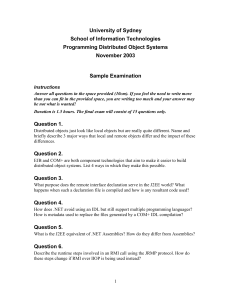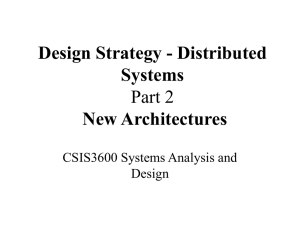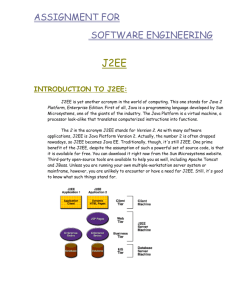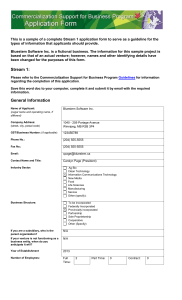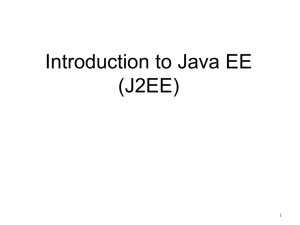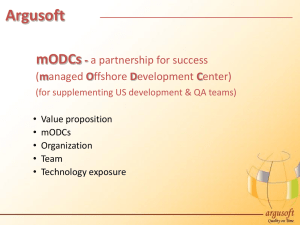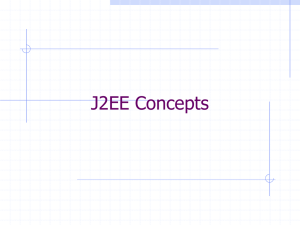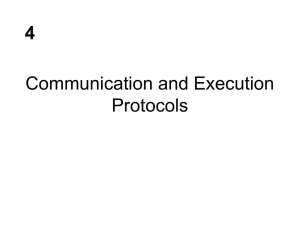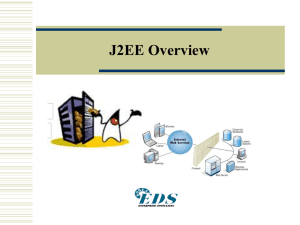File
advertisement
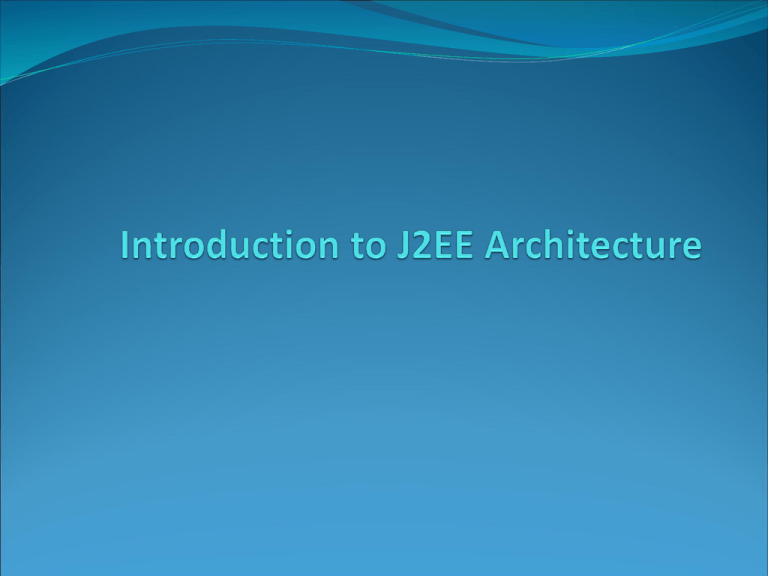
Distributed Multi-tiered Applications The J2EE platform uses a multi-tiered distributed application model for both enterprise applications Application logic is divided into “components” according to function, and the various application components that make up a J2EE application are installed on different machines depending on the tier in the multi-tiered J2EE environment to which the application component belongs The J2EE technologies can be broadly classified into four different categories: Client-side technologies Component technologies Service technologies Communication technologies Component technologies include: Servlets Java Server Pages Enterprise JavaBeans Session Beans Entity Beans Service Technologies include: Java Database Connectivity Java Transaction API and Service Client-Server Architecture SERVER CLIENT Application Business Logic Data Presentation Logic Clear division between Application and Data Entire processing load on client Server acts as traffic controller 2-Tier Architecture J2EE/ Session 3/Slide 4 of 49 Client-Server: The Drawbacks Business logic present on each client Client waits longer for response Business logic + presentation logic bundled together-therefore scalability problems Load on server and network as all clients send request to 1 server Tiny change to application— entire application has to be changed, and the clients upgraded 3-Tier Architecture CLIENT TIER Presentation Logic MIDDLE TIER/ APPLICATION TIER Business Logic Receives request for data, retrieves it, and returns it to client J2EE/ Session 3/Slide 6 of 49 DATA/EIS TIER DATA 3-Tier Architecture: the benefits Firewall Business logic shared between clients; same data returned by data & application tier –presented differently on different clients Business logic can be changed without impacting clients Middle tier can be hidden behind firewall Application Maximum Server use of available system resources Parts of architecture can be rewritten without rewriting whole app J2EE/ Session 3/Slide 7 of 49 Traditional n-Tier Architecture Application Logic= Presentation logic + Business Logic Infrastructure services provide additional functionalities required by application, such as messaging services and transactional services. J2EE/ Session 3/Slide 8 of 49 Traditional n-Tier Architecture: The Characteristics Business logic and presentation logic in same module Database connectivity through same module Scalability low Business logic difficult to update Client & Server – stateless communication Business logic unaware of different client identities Client has to maintain state J2EE/ Session 3/Slide 9 of 49 Overcoming the drawbacks Improving the system Middle Tier contains one App object Extend the middle tier to create one more layer For different types of needsdifferent app objects required Allow multiple application objects to reside on the server Different application objects may not be able to communicate with each other Use interfaces to communicate between application objects J2EE/ Session 3/Slide 10 of 49 Component n-tier Architecture Interface s Component A Component B Database Component C Application object broken into components that can communicate with each other, through interfaces J2EE/ Session 3/Slide 11 of 49 Component Based n-Tier Systems Comp A Comp B Database Comp C Component objects maintain identity and encapsulate remote methods Components can be designed to maintain session state on server Business logic can be modified without affecting other logic J2EE/ Session 3/Slide 12 of 49 Layered Architecture Component A Component B Component C M I D D L Database E W A R EJDBC-ODBC Bridge, perhaps J2EE/ Session 3/Slide 13 of 49 Various models of architecture Client-Server Component-based n-Tier Layered Depends on Distributed nature of application Scalability Performance Memory Management J2EE/ Session 3/Slide 14 of 49 J2EE Architecture J2EE is a layered architecture J2EE framework designed based on… Using these we can design applications that are… Scalable J2EE/ Session 3/Slide 15 of 49 J2EE Architecture J2EE multi-tiered applications are generally considered to be threetiered applications because they are distributed over three different locations client machines the J2EE server machine the database or legacy machines at the back end J2EE Architecture Three-tiered applications that run in this way extend the standard two-tiered client and server model by placing a multithreaded application server between the client application and back-end storage J2EE goals Robustness Scalability Simplicity Maintainability Testability Reusability J2EE Containers The application server maintains control and provides services through an interface or framework known as a container There are five defined container types in the J2EE specification J2EE Containers Three of these are server-side containers: The server itself, which provides the J2EE runtime environment and the other two containers An EJB container to manage EJB components A Web container to manage servlets and JSP pages The other two container types are client-side: An application container for stand-alone GUIs, console An applet container, meaning a browser, usually with the Java Plug-in J2EE Container Two most important containers: Web Components (JSP/Servlets) • Manages threading for components • Provides necessary interface with web server EJBs • Holds the following components: - Entity beans - Stateful session beans - Stateless session beans - Message beans Containers provide medium for services to communicate with domain layer J2EE/ Session 3/Slide 21 of 49 J2EE Components As said earlier, J2EE applications are made up of components A J2EE component is a self-contained functional software unit that is assembled into a J2EE application with its related classes and files and that communicates with other components Components Client components run on the client machine, which correlate to the client containers Web components -servlets and JSP pages EJB Components Packaging Applications and Components Under J2EE, applications and components reside in Java Archive (JAR) files These JARs are named with different extensions to denote their purpose, and the terminology is important Various File types Enterprise Archive (EAR) files represent the application, and contain all other server-side component archives that comprise the application Client interface files and EJB components reside in JAR files Web components reside in Web Archive (WAR) files Deployment Descriptors Deployment descriptors are included in the JARs, along with component-related resources Deployment descriptors are XML documents that describe configuration and other deployment settings (remember that the J2EE application server controls many functional aspects of the services it provides) The statements in the deployment descriptor are declarative instructions to the J2EE container; for example, transactional settings are defined in the deployment descriptor and implemented by the J2EE container Deployment Descriptors Most J2EE Web Services vendors provide a GUI tool for generating deployment descriptors and performing deployment because creating manual entries is tedious and error prone The deployment descriptor for an EJB component must be named ejb-jar.xml, and it resides in the META-INF directory inside the EJB JAR file EJB Components EJB components are server-side, modular, and reusable, comprising specific units of functionality They are similar to the Java classes we create every day, but are subject to special restrictions and must provide specific interfaces for container and client use and access We should consider using EJB components for applications that require scalability, transactional processing, or availability to multiple client types EJB Components- Major Types Session beans These may be either stateful or stateless and are primarily used to encapsulate business logic, carry out tasks on behalf of a client, and act as controllers or managers for other beans Entity beans Entity beans represent persistent objects or business concepts that exist beyond a specific application's lifetime; they are typically stored in a relational database
